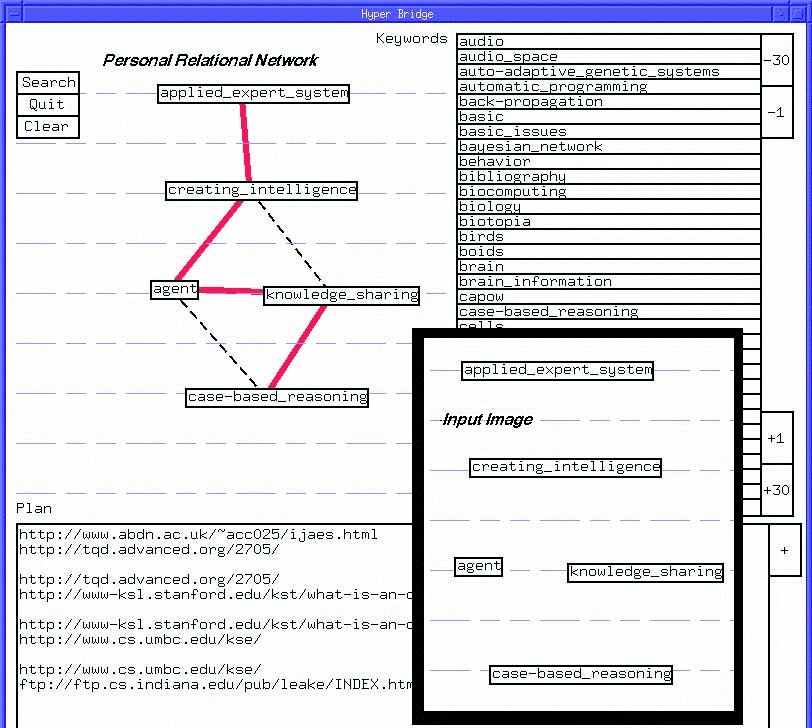
Department of Systems and Human Science, Osaka University
New topics may sound fairly interesting, but it is not obvious what importance the topics carry. In fact, "Internet" sounded curiously attractive 10 years ago, without embodied feeling of its role in our daily life as it does now. Generally, lack and gaps of people's vocabulary [1] cause their comprehension to be too vague to talk about new topics.
In order to acquire vocabulary, it is effective to read multiple documents in series from fundamental concepts, for understanding advanced new topics. PTHB is an interface for guiding a user to understand if or why a new topic (Goal term) is important for one's interest, in concrete words. The user expresses vague interest through a 2-D graphical interface to the system. The system returns a list of Web-sites, for the user to read in series. The benefit of PTHB is that the user comes to a concrete understanding of the Goal term through easy and efficient interface.
2. Personal and temporary hyper bridges (PTHB)
the user is instructed by PTHB. This instruction enhances the tendency that one places each term near subconsiously relevant terms [2, 3]. The system obtains a personal relational network by connecting near-by terms in the input image by links. In Fig. 1, "applied expert systems" is the Goal term and "case-based reasoning" is the Start term. Terms between them form bridges (dotted or solid lines in the left of Fig. 1) between Goal and Start.
By thus visualizing links between terms, the user can see whether the personal relational network matches her/his own mind. The user can revise the personal relational network by moving terms, if the user becomes aware that she/he made a failure. Another merit of putting terms in the 2-dimensional image is that the user can express the vagueness in one's own mind. In Fig. 1, it may not be obvious which of "agent" or "knowledge-sharing" should be nearer to "creating intelligence" if the user does not have a concrete idea on the roles of these two terms in "intelligence creation". It is convenient that a user is allowed to put both terms equally near to "creating intelligence."
Next, the personal relational network Np is projected onto the hyper links in the Internet Nw. Nw is made of nodes (sites), each of which are assigned keywords (given by KEYWORD meta-tags or external indexing devices) and hyper links. Thus obtained keyword-site pairs are seen as relational links between sites in Nw and keywords. We refer to this network made of thus acquired relational links and nodes (keywords), as Nq. Then runs the following procedure.

Fig. 1. A user input image (right) and the corresponding personal relational network (upper-left).
The system is written in C++ and Pearl, on a computer of Pentium 200MHz / 128 MB. Current users are beginners and seniors of research in artificial intelligence. Experiments here were made with restricting Nw into the area of computer science in Yahoo. We first evaluated user's satisfaction s, defined as (the number of satisfactorily answered queries) / (number of queries).
For Yahoo, s came to be 9/15 (3 terms input), 8/21 (5 terms input), 3/17 (7 terms input). On the other hand, for PTHB s = 14/20 (3 terms input), 12/19 (5 terms input), 7/12 (7 terms input). We notice that user satisfaction decreased with an increase in the number of input terms. For Yahoo, this is because users have no chance to distinguish Goal, Start, and other terms in search key terms. For PTHB, on the other hand, the growth in the complexity of the personal relational network discouraged the user from revising the personal relational network. Shortest paths also became harder to obtain for a large number of input terms. However, the results of PTHB were better than Yahoo, both in the rate of satisfactory answers and the rate of decrease with respect to the number of input terms.Next, the times of user's input revision (by moving terms) in a 1-dimensional (i.e., aligning terms within a line in PTHB) and 2-dimensional interface were examined. 3.9 times of revisions in average were required in the 1-dimensional, while 2.4 times for the 2-dimensional placing of terms. Even after so many revisions in the 1-dimensional interface, the user was satisfied for only 26 of 62 queries while 48 of 62 queries were satisfactory for the 2-dimensional.
PTHB is presented for satisfying user's vague interest in undefined new topics. Users of PTHB learned to express their own interest in concrete words. It was sometimes difficult for a user to place terms in the image, if her/his vocabulary was very poor. However, users soon learned appropriate input words, and relocated them for new input to PTHB until satisfactory results were obtained. Users came to find new research directions and join discussions from which they felt themselves isolated before using PTHB.
URL List
Yahoo =http://www.yahoo.com/Science/Computer_Science/